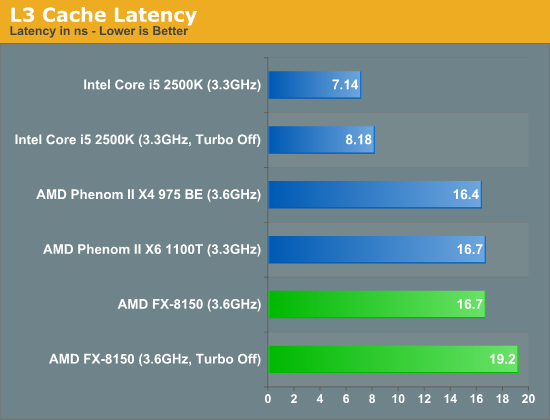The Bulldozer Review: AMD FX-8150 Tested
by Anand Lal Shimpi on October 12, 2011 1:27 AM ESTCache and Memory Performance
I mentioned earlier that cache latencies are higher in order to accommodate the larger caches (8MB L2 + 8MB L3) as well as the high frequency design. We turned to our old friend cachemem to measure these latencies in clocks:
| Cache/Memory Latency Comparison | ||||||
| L1 | L2 | L3 | Main Memory | |||
| AMD FX-8150 (3.6GHz) | 4 | 21 | 65 | 195 | ||
| AMD Phenom II X4 975 BE (3.6GHz) | 3 | 15 | 59 | 182 | ||
| AMD Phenom II X6 1100T (3.3GHz) | 3 | 14 | 55 | 157 | ||
| Intel Core i5 2500K (3.3GHz) | 4 | 11 | 25 | 148 | ||
Cache latencies are up significantly across the board, which is to be expected given the increase in pipeline depth as well as cache size. But is Bulldozer able to overcome the increase through higher clocks? To find out we have to convert latency in clocks to latency in nanoseconds:

We disable turbo in order to get predictable clock speeds, which lets us accurately calculate memory latency in ns. The FX-8150 at 3.6GHz has a longer trip down memory lane than its predecessor, also at 3.6GHz. The higher latency caches play a role in this as they are necessary to help drive AMD's frequency up. What happens if we turn turbo on and peg the FX-8150 at 3.9GHz? Memory latency goes down. Bulldozer still isn't able to get to main memory as quickly as Sandy Bridge, but thanks to Turbo Core it's able to do so better than the outgoing Phenom II.

L3 access latency is effectively a wash compared to the Phenom II thanks to the higher clock speeds enabled by Turbo Core. Latencies haven't really improved though, and Bulldozer has a long way to go before it reaches Sandy Bridge access latencies.










430 Comments
View All Comments
madseven7 - Thursday, October 13, 2011 - link
How could the 6core fx be competitive? For $169 you could get a Phenom 2 that beats the 8150 fx. Imagine what it would do to the 6 core fx chip?jerkstorez - Wednesday, October 12, 2011 - link
Was pretty hyped for this chip to come out, and if it was a decent performance boost, I was ready to upgrade from my Phenom II 1090t. It looks like it'd barely an upgrade in many areas and a definite downgrade in others. With a whole new architecture and all the hype, I expected a lot more, at least better performance than the current generation of AMD chips. Very disappointed.boobox - Wednesday, October 12, 2011 - link
What is with the settings choice for all these benchmarks?Who is buying these processors and running games on medium settings and such low resolutions?
I was hoping to see 1920x1080 at least for tests on the highest settings.
JarredWalton - Wednesday, October 12, 2011 - link
It's a CPU review, so settings were selected to show both CPU-limited (or at least more CPU limited) and GPU-limited (or more GPU limited than CPU). And of course, that's only one facet of the overall review.tipoo - Wednesday, October 12, 2011 - link
Maxing out the GPU would create a bottleneck and hide the CPU's performance.CoolGoodGuy - Wednesday, October 12, 2011 - link
I read this extensive review. However after the last page, your mention about "windows scheduler problem" made me to think this tests might be Biased. So, I thought of posting this comment.Windows is compiled using Intel Compiler which optimises code very well for Intel processors but doesn't do that for AMD. Where as Linux is mostly compiled using GNU GCC. So, Linux bench marks would be more neutral for both Intel and AMD processors.
Also, now a days a lot of Desktop users have started using Linux Distros like UBUNTU, and in servers Linux is mainstream.
Server users would be greatly benefited by a Linux CPU benchmark.
So, I would request you to include Linux benchmarks for processors in your reviews.
Thanks,
JarredWalton - Wednesday, October 12, 2011 - link
Server benchmarks will be coming from Johan at some point, though obviously those require a lot of time to put together. As for the compiler of Windows, you're never going to change that, and Windows is still 90%+ of the market. Ultimately, as a hardware manufacturer you need to make hardware that runs the stuff people are doing faster than the competition or there's not much point. It's like having the world's fastest GPU with crappy drivers: no one will like it because it can't run games.FunBunny2 - Wednesday, October 12, 2011 - link
Here's your answer:http://developer.amd.com/tools/gnu/pages/default.a...
Burticus - Wednesday, October 12, 2011 - link
Wait wait wait wait wait, wait some more, wait for years... then.... bleh. Doesn't even match up to the last product. That is not the way to move the bar forward or stay in business, AMD.At some point why didn't someone just say.... you know what? This thing may sell like hotcakes for servers but just doesn't make sense for desktop. Sell the Opterons to get that server profit margin, and just die shrink the Thuban and make it faster for desktop. Know when something is a lost cause and fold the hand already.
Geforce man - Wednesday, October 12, 2011 - link
Any chance for a few benchmarks at the overclocked settings? it would be quite interesting to see, as the 4.6Ghz range seems to be a common OC for an i7 2600k (Obviously this would be slower, but it'd be nice to see)